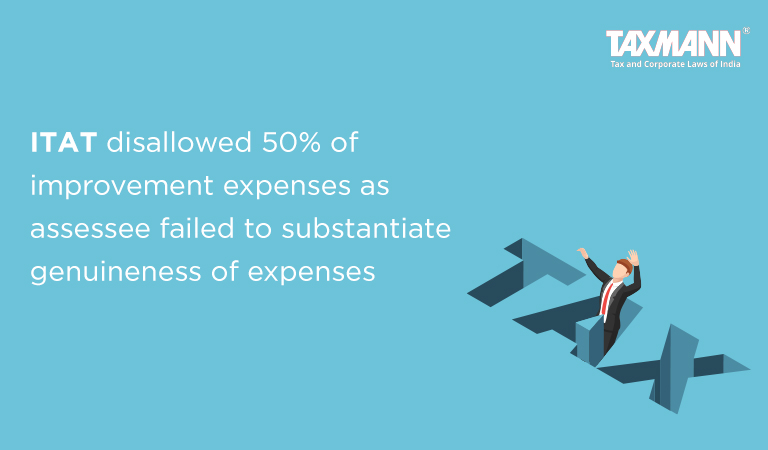ITAT disallowed 50% of improvement expenses as assessee failed to substantiate genuineness of expenses
- Blog|News|Income Tax|
- 2 Min Read
- By Taxmann
- |
- Last Updated on 3 January, 2023
Case Details: Assistant Commissioner of Income-tax v. Amrutlal Babaldas Patel - [2022] 145 taxmann.com 505 (Surat-Trib.)
Judiciary and Counsel Details
-
- Pawan Singh, Judicial Member & Dr Arjun Lal Saini, Accountant Member
- Sita Ram Meena, Sr. DR for the Appellant.
- Jimit Shah, CA for the Respondent.
Facts of the Case
Assessee-individual, filed a return of income showing capital gains arising from sale of non-agricultural land. While computing the capital gains, assessee claimed deduction for land filling, excavation and other miscellaneous charges for such land as cost of improvement.
During the scrutiny proceedings, the Assessing Officer (AO) demanded certain clarifications regarding development expenses. AO noticed that the invoices provided were not having required service tax registration number and accused the assessee of fabricating the details in order to inflate the cost of improvement. Further, the payment to contractors was made after a long period of time.
Not satisfied with the assessee’s clarifications, AO disallowed the development expenses and computed the capital gains accordingly. Aggrieved- assessee preferred an appeal to the CIT(A). The CIT(A) deleted the entire addition made by AO and the matter reached the Surat Tribunal.
ITAT Held
The Tribunal held that the improvement work was generally labour intensive, performed by the unorganised laborers who cannot wait for their payment for years. The assessee’s claim was not credible due to the significant delay in paying the contractor. In addition payment to such contractors were made only after the case was selected for scrutiny.
However, there was no dispute as to the nature of work performed on such land, there was nothing available with the assessee to show the written proof to the said arrangement of making late payments to the contractors. The assessee did not provide any supporting documentation for their claim but only made a self-serving statement, which cannot be accepted. The reply given by the assessee further undermines the authenticity of the payment to the contractor.
Since, there was no doubt about the work performed, ITAT directed AO to disallow the 50% of the cost of improvement out of the total costs.
List of Cases Referred to
-
- Dhakeswari Cotton Mills v. CIT [1954] 26 ITR 775 (SC) (para 9).
Disclaimer: The content/information published on the website is only for general information of the user and shall not be construed as legal advice. While the Taxmann has exercised reasonable efforts to ensure the veracity of information/content published, Taxmann shall be under no liability in any manner whatsoever for incorrect information, if any.

Taxmann Publications has a dedicated in-house Research & Editorial Team. This team consists of a team of Chartered Accountants, Company Secretaries, and Lawyers. This team works under the guidance and supervision of editor-in-chief Mr Rakesh Bhargava.
The Research and Editorial Team is responsible for developing reliable and accurate content for the readers. The team follows the six-sigma approach to achieve the benchmark of zero error in its publications and research platforms. The team ensures that the following publication guidelines are thoroughly followed while developing the content:
- The statutory material is obtained only from the authorized and reliable sources
- All the latest developments in the judicial and legislative fields are covered
- Prepare the analytical write-ups on current, controversial, and important issues to help the readers to understand the concept and its implications
- Every content published by Taxmann is complete, accurate and lucid
- All evidence-based statements are supported with proper reference to Section, Circular No., Notification No. or citations
- The golden rules of grammar, style and consistency are thoroughly followed
- Font and size that’s easy to read and remain consistent across all imprint and digital publications are applied








 CA | CS | CMA
CA | CS | CMA


